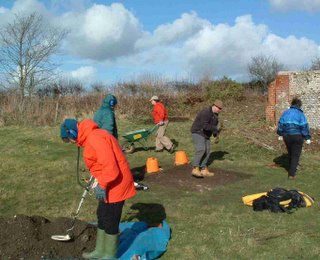Binsted - West Sussex 2005
Spring is here, and the new excavation season is rapidly approaching! However, I though I would post details of one of last years excavations with the Worthing Archaeological Society (http://worthingpast.blogspot.com/).
The excavation took place at Binsted in West Sussex between 27 August 2005 and 11 September 2005. Previous work had been undertaken in the 1960's, and a test pitting exercise in 2001 had provided evidence that a tile kiln was located on the site.
 The site was examined by magnetometry, and a distinct 'spike' was clearly visible. However, the large amounts of broken tile laying around the field were also a good indiciation of where the kiln would be located!
The site was examined by magnetometry, and a distinct 'spike' was clearly visible. However, the large amounts of broken tile laying around the field were also a good indiciation of where the kiln would be located!During the first two days of the dig, we located a large area of chalk blocks which were defined by linear bands of red tiles. A number of voids were evident between the chalk blocks, and these were measured to be up to 0.5 metre deep.
 The whole area under excavation was rich with broken fragments of tile. The area of chalk blocks was also beginning to reveal a number of highly fired tile bars. Care had to be taken as it became obvioud that there were large areas of vpoids under the chalk layer, and the lightest member of the excavation team had the job of cleaning back the chalk!
The whole area under excavation was rich with broken fragments of tile. The area of chalk blocks was also beginning to reveal a number of highly fired tile bars. Care had to be taken as it became obvioud that there were large areas of vpoids under the chalk layer, and the lightest member of the excavation team had the job of cleaning back the chalk! The chalk blocks were gradually removed to reveal the tile bars that made up the floor of the firing chamber. Sondage trenches were also dug along the sides of the structure to reveal that the kiln had actually been constructed of tiles which had been stacked together to form the walls.
The chalk blocks were gradually removed to reveal the tile bars that made up the floor of the firing chamber. Sondage trenches were also dug along the sides of the structure to reveal that the kiln had actually been constructed of tiles which had been stacked together to form the walls.A sondage trench was dug along the north side of the structure as we had determined that this would be the site of the entrance to the firing chamber. Eventually, we removed the whole of the area of chalk blocks, and extended the sondage trenches aroud the whole area of the kiln structure. The preservation of the firing bars and kiln structure was extremely good, partially thanks to the careful ploughing of the farmer, who always raised the plough when approaching the structure.

On the floor at the entrance to the firing chamber, two beer flagons were found, which were dated to the 13th or 14th century. The flagons showed no sign of burning, and therefore helped to provide good dating evidence for the last firing of the kiln.
Having fully excavated the strucure over two weeks, we had found a number of sherds of medieval green glazed pottery and more than 1.3 metric tons of tile, including decorated ridge tiles. The structure was recorded, and then the chalk blocks were replaced to cover and protect the kiln, and then the excavation was back filled.
It has been decided to revisit the site in 2006 to examine the entrance to the kiln, along with a possible chalk packed road that was found to one side of the structure.


